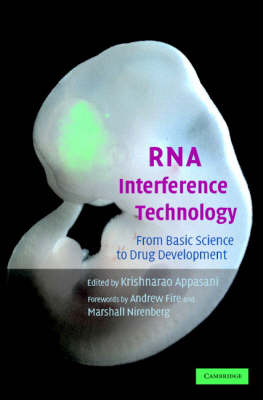
RNA Interference Technology
Cambridge University Press (Verlag)
978-0-521-83677-7 (ISBN)
- Titel z.Zt. nicht lieferbar
- Versandkostenfrei
- Auch auf Rechnung
- Artikel merken
RNA Interference (RNAi) technology has rapidly become one of the key methods used in functional genomics. RNAi is used to block the expression of genes and create phenotypes that can potentially yield clues about the function of these genes. In the postgenomic era, the elucidation of the physiological function of genes has become the rate-limiting step in the quest to develop 'gene-based drugs' and RNAi could potentially play a pivotal role in the validation of such novel drugs. In this overview, the basic concepts and applications of RNAi biology are discussed. Leading experts from both academia and industry have contributed to this invaluable reference. The volume is forwarded by Andrew Fire, one of the winners of the 2006 Nobel Prize for the discovery of RNA Interference.
Krishnarao Appasani is the Founder of GeneExpression Systems, a gene discovery company focusing on functional genomics in cancer research.
Part I. Basic RNAi, siRNA and Gene Silencing Mechanisms: 1. RNAi beginnings: overview of the pathway in C. elegans; 2. Dicer in RNAi: its roles in vivo and utility in vitro; 3. Genes required for RNAi; 4. MicroRNAs: a small contribution from worms; 5. miRNAs in the brain and the application of RNAi to neurons; Part II. Design and Synthesis of siRNAs: 6. Design and synthesis of small interfering RNA (siRNA); 7. Automated design and high throughput synthesis of siRNA; 8. Rational design of siRNAs with the Sfold software; 9. Enzymatic production of siRNAS; Part III. Vector Development and In Vivo, In Vitro and In Ovo Delivery Methods: 10. Six methods of inducing RNAi in mammalian cells; 11. Viral delivery of siRNA; 12. siRNA delivery by lentiviral vectors: design and applications; 13. Liposomal delivery of siRNAs in mice; 14. Chemical modifications to achieve increased stability and sensitive detection of siRNA; 15. RNAi in postimplantation mouse embryos; 16. In ovo RNAi opens new possibilities for functional genomics in vertebrates; Part IV. Gene Silencing in Model Organisms: 17. Practical applications of RNAi in C. elegans; 18. Inducible RNAi as a forward genetic tool in Trypanosoma brucei; 19. RNAi gene silencing in yeast; 20. RNA silencing in filamentous fungi: Mucor circinelloides as a model organism; 21. RNAi and gene silencing phenomenon mediated by viral suppressors in plants; Part V. Drug Target Validation: 22. Delivering siRNA in vivo for functional genomics and novel therapeutics; 23. The role of RNAi in drug target validation: application to Hepatitis C; 24. RNAi in the drug discovery process; 25. RNAi: use in the drug discovery process; Part VI. Therapeutic and Drug Development: 26. RNAi-mediated silencing of viral gene expression and replication; 27. RNAi in drug development: practical considerations; 28. RNAi for the treatment of liver diseases; 29. RNAi applications in animal systems; Part VII. Genome Wide RNAi and High Through-Put Analysis: 30. High through-put RNAi-by-soaking in Caenorhabditis elegans; 31. Tools for integrative genomics: genome-Wide RNAi and expression profiling in Drosophila; 32. Microarray analysis and RNA silencing to determine genes functionally important in Mesothelioma; 33. High through-put RNAi; 34. Generation of highly specific vector-based shRNAi libraries directed against the entire human genome.
| Erscheint lt. Verlag | 17.1.2005 |
|---|---|
| Vorwort | Andrew Fire, Marshall Nirenberg |
| Verlagsort | Cambridge |
| Sprache | englisch |
| Maße | 183 x 260 mm |
| Gewicht | 1292 g |
| Themenwelt | Informatik ► Weitere Themen ► Bioinformatik |
| Naturwissenschaften ► Biologie ► Genetik / Molekularbiologie | |
| ISBN-10 | 0-521-83677-8 / 0521836778 |
| ISBN-13 | 978-0-521-83677-7 / 9780521836777 |
| Zustand | Neuware |
| Haben Sie eine Frage zum Produkt? |
aus dem Bereich


